The Sinus Dilation Devices Market is estimated to be valued at USD 2.9 billion in 2025 and is projected to reach USD 6.5 billion by 2035, registering a compound annual growth rate (CAGR) of 8.5% over the forecast period.
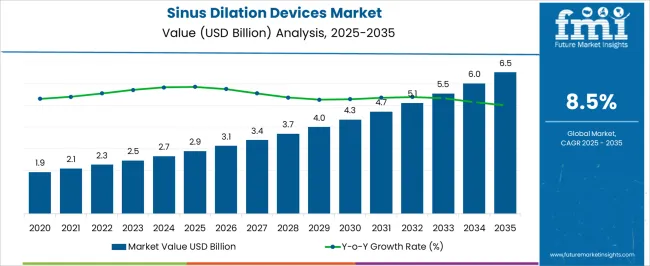
| Metric | Value |
|---|---|
| Sinus Dilation Devices Market Estimated Value in (2025 E) | USD 2.9 billion |
| Sinus Dilation Devices Market Forecast Value in (2035 F) | USD 6.5 billion |
| Forecast CAGR (2025 to 2035) | 8.5% |
The sinus dilation devices market is witnessing steady expansion, supported by the rising prevalence of chronic sinusitis and the growing preference for minimally invasive treatment options. The adoption of advanced dilation systems is being reinforced by the clinical benefits they offer, including reduced recovery times, lower complication risks, and improved patient comfort compared to traditional surgical interventions. Increasing awareness among patients and healthcare providers about minimally invasive sinus therapies is also driving procedural volumes.
The market is further influenced by continuous technological innovation, such as image-guided navigation systems and enhanced balloon dilation devices, which improve procedural accuracy and safety. Expanding healthcare infrastructure and greater access to advanced ENT treatments in emerging economies are supporting wider availability of these devices.
Regulatory approvals and favorable reimbursement frameworks in developed markets are also encouraging adoption As the burden of sinus-related disorders continues to rise globally, the demand for efficient, patient-centric solutions is expected to position sinus dilation devices as an essential component of ENT treatment, ensuring sustained market growth over the forecast period.
The sinus dilation devices market is segmented by product type, end user, and geographic regions. By product type, sinus dilation devices market is divided into Balloon Sinuplasty Systems, Sinus Ventilation Devices, Distal Suction Blades, Sinoscopes, Sinus Seekers, Nasal Catheters, Nasal Forceps, and Others. In terms of end user, sinus dilation devices market is classified into Hospitals, Specialty Clinics, and Ambulatory Surgical Centers. Regionally, the sinus dilation devices industry is classified into North America, Latin America, Western Europe, Eastern Europe, Balkan & Baltic Countries, Russia & Belarus, Central Asia, East Asia, South Asia & Pacific, and the Middle East & Africa.
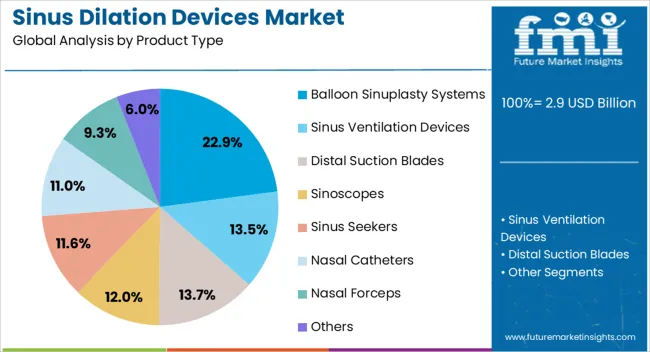
The balloon sinuplasty systems segment is projected to account for 22.9% of the sinus dilation devices market revenue share in 2025, making it a leading product type. Its growth is being supported by the minimally invasive nature of balloon dilation procedures, which preserve mucosal tissue and reduce patient discomfort while offering long-term relief from chronic sinusitis. These systems are gaining preference due to their ability to be performed in outpatient or office-based settings, lowering the need for hospitalization and reducing healthcare costs.
The high success rate in restoring natural sinus drainage and improving quality of life has reinforced clinical adoption. Technological advancements are enabling the development of more flexible and precise balloon catheters, allowing safer and more effective navigation in complex anatomies.
Rising awareness among patients about less invasive treatment options and favorable insurance coverage in key markets are further supporting demand As physicians and healthcare systems continue to prioritize patient outcomes and cost efficiency, balloon sinuplasty systems are expected to remain a critical growth driver within the overall product portfolio.
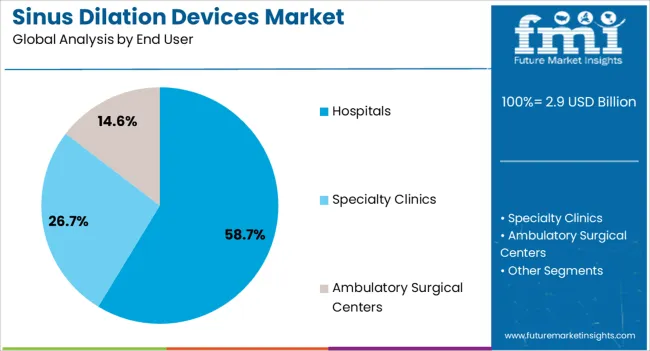
The hospitals segment is anticipated to represent 58.7% of the sinus dilation devices market revenue share in 2025, making it the leading end user. This leadership is being reinforced by the concentration of advanced ENT facilities and the availability of skilled otolaryngologists within hospital settings. Hospitals are better equipped to handle complex sinus procedures, including cases requiring advanced imaging and anesthesia support, which increases reliance on these environments for sinus dilation treatments.
Favorable reimbursement frameworks for hospital-based procedures in developed markets are also contributing to the segment’s growth. Additionally, hospitals often act as referral centers for complicated sinus cases that cannot be managed in outpatient clinics, further consolidating their role as primary end users.
The ability to provide comprehensive pre-operative and post-operative care within hospital infrastructures is enhancing patient confidence and outcomes, thereby boosting adoption As the prevalence of sinus disorders increases and demand for minimally invasive interventions grows, hospitals are expected to remain the dominant setting for sinus dilation procedures, ensuring consistent demand for advanced device solutions.
Sinuplasty systems supplied by key manufacturers allow skilled Otolaryngologists to dilate clogged sinus Ostia and airways in sinusitis patients using endoscopic procedures. The system is built on a flexible, over-the-wire design that allows a clinician to negotiate complex sinus anatomy while confirming device position with the sinus illumination system focused light.
Furthermore, sinuplasty technology adds to the progress of sinus surgery by providing a surgeon with extra instruments for endoscopic surgery. Additionally, sinuplasty products are catheter-based devices that help Otolaryngologists achieve their surgical aims of clearing clogged sinuses, restoring normal sinus drainage and function, and conserving normal architecture and mucosal tissue. During balloon sinus surgery, the adoption of sinus dilation device systems is rising as they feature rigid balloon sinus seekers that have been pre-calibrated for surgical navigation using navigation systems.
End users can utilize these technologies provided by major suppliers to find and move tissue, bone, or cartilage along sinus drainage routes. Furthermore, balloon sinus dilation offers doctors easy, targeted balloon sinus surgery devices with built-in electromagnetic (EM) surgical navigation technology.
In contrast, a eustachian tube dilation balloon is a manually controlled balloon catheter device that expands and dilates the eustachian tube canal. The demand for sinus dilation devices is rising, especially for ENT navigation systems, since they have been successfully launched by key firms. They were developed and manufactured by the company's ENT branch of its surgical technology business. Key clinicians' surgical technologies create products and procedural solutions for surgical applications such as ear, nose, and throat; cranial and functional neurosurgery; spinal and orthopedics; and general surgical cancer.
The majority of medical device firms are focused on creating innovative medicines to enhance people's sinus health. Their sinus dilation devices are intended to alleviate sinusitis symptoms in a straightforward two-step interventional procedure. The sales of sinus dilation devices are likely to surge as it allows for progressive dilatation of the maxillary sinus Ostia, which is intended to improve patient comfort during the treatment in an office environment under local anesthetic.
The sinus dilation system, as opposed to balloon dilation devices that employ quick, high-pressure inflation, is a tiny, low-pressure, self-expanding insert meant to softly and gradually dilate the maxillary Ostia. The sinus dilation devices market growth is expected to be driven as they are developed using the concerned company's unique osmotic technology, which uses the body's natural mucosal fluids to enlarge the insert before removal. Patients are pleasantly transported to the waiting room in an office environment between device insertion and removal. These factors are estimated to be the growth of the sinus dilation devices market growth.
Extracorporeal septoplasty is considered medically required for the first treatment of a highly deviated nasal septum that cannot be properly corrected using an intranasal technique for members who match the septoplasty criteria given above. For all other purposes (e.g., allergic rhinitis), they consider septoplasty experimental and exploratory since its efficacy in comparison to other kinds has not been shown.
Most major corporations offer a diverse sinus surgery portfolio tailored to address the expanding demands of sinus surgeons. From their sinus dilation devices, a new breakthrough that aids patients with sinus difficulties, to their gel knit, detachable nasal dressing, which is meant to minimize post-op adhesions, key players are continuously innovating products. These factors are anticipated to drive product demand and expand the global sinus dilation device market size in the forecast period.
Sinuses are the hollow sacks in the head which are responsible for secretion of mucus and provide resonance to the voice. The mucus secreted by the sinuses prevents the nasal cavity from drying and works by trapping the foreign particles that enter the nasal passage and reaching to lungs.
The sinuses have an opening that allows the mucus to drain from and flow into nasal passage, however in some cases the sinus opening gets blocked, and the mucus remains logged into the sinus causing headache, congestion, and inflammation of the sinus, it also increases the risk of causing an infection, this condition is termed as sinusitis.
Depending on the duration of the symptoms, sinusitis is classified into three types, acute, sub - acute and chronic. The treatment of sinusitis depends on the longevity of the infection. To relieve the patient from the symptoms, treatment options like drugs, surgery, and physical therapy are available.
In the chronic case where the sinuses remain blocked for a longer time, the doctors opt for surgery. The rhinoplasty surgery is a procedure in which surgeons dilate the sinuses to relieve the mucus and decrease pressure in the sinuses.
The growing incidence of sinusitis is expected to boost demand for sinus dilation devices worldwide. According to the Center of Disease Control and Prevention (CDC), in the USA nearly 12% of the population in the age group of 18 years and above suffer from sinusitis.
The increasing rate of chronic sinusitis is expected to provide high growth opportunities for the sinus dilation devices manufacturers.
Moreover, the development of new devices and technologies like balloon sinus dilation systems more physicians are expected to opt for these devices for treating sinusitis, as these devices are more effective and less invasive the risk to patients is minimal, which in turn is expected to create high demand from the patients as well as physicians.
Several companies like Medtronic and Acclarent, Inc. are focused on the development of new products for sinus dilation which in turn is expected to increase adoption of new technology-based products owing to increasing availability of these products in the market.
However, prescription drugs like antibiotics and decongestants, being the primary treatment method for treatment of sinusitis the adoption of devices for sinus dilation is comparatively low, which in turn is expected to reduce revenue growth of the sinus dilation devices market.
Globally the sinus dilation devices market is expected to witness robust growth over the forecast period owing to new product development, products which are less invasive and easy to use in physician office settings are expected to gain traction over the forecast period.
Moreover increasing distribution network of manufacturers and growing awareness among the physicians is expected to create high growth opportunities for the stakeholders of sinus dilation devices market.
Regionally, sinus dilation devices market is segmented into seven key regions, North America, Latin America, Western Europe, Eastern Europe, APEJ (Asia-Pacific excluding Japan), Japan and the Middle East and Africa (MEA)
North America is expected to dominate the sinus dilation devices market over the forecast period. According to the USA statistics of CDC in 2025, 29 million people in the USA were affected with chronic sinusitis and is ranked as one of the ten costliest physical health conditions.
The demand for rapid treatment offered by new sinus dilation systems is expected to create increase over the forecast period. Western Europe is expected to follow next after North America owing to increasing awareness of sinus dilation devices in this region.
Increasing incidence of chronic sinusitis and large patient pool in APEJ region is expected to boost demand for sinus dilation devices in this regions. Japan is expected to follow next regarding revenue growth owing to technological developments and an introduction of new products from the local players.
Latin America and MEA regions are also expected to witness significant growth in sinus dilation devices market over the forecast period.
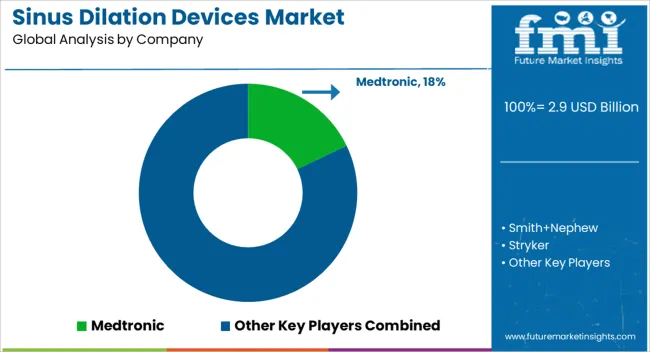
Some key players in the sinus dilation devices market include Acclarent, Inc., Medtronic, Entellus Medical, Inc., SinuSys Corporation., Smith & Nephew plc. Aetna, Inc., KARL STORZ GmbH & Co. KG, Olympus Corporation and others
The research report presents a comprehensive assessment of the market and contains thoughtful insights, facts, historical data, and statistically supported and industry-validated market data.
It also contains projections using a suitable set of assumptions and methodologies. The research report provides analysis and information according to categories such as market segments, geographies, types, technology and applications.
The report is a compilation of first-hand information, qualitative and quantitative assessment by industry analysts, inputs from industry experts and industry participants across the value chain. The report provides in-depth analysis of parent market trends, macro-economic indicators and governing factors along with market attractiveness as per segments. The report also maps the qualitative impact of various market factors on market segments and geographies.
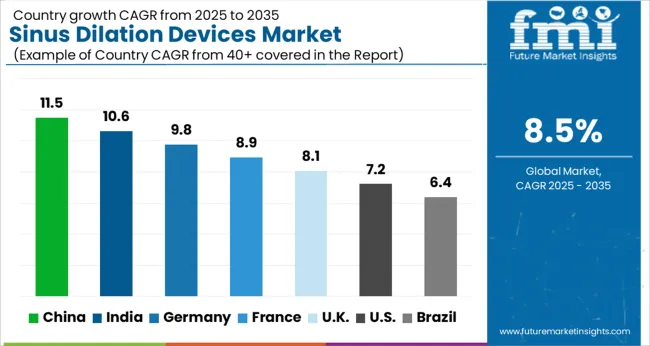
| Country | CAGR |
|---|---|
| China | 11.5% |
| India | 10.6% |
| Germany | 9.8% |
| France | 8.9% |
| UK | 8.1% |
| USA | 7.2% |
| Brazil | 6.4% |
The Sinus Dilation Devices Market is expected to register a CAGR of 8.5% during the forecast period, exhibiting varied country level momentum. China leads with the highest CAGR of 11.5%, followed by India at 10.6%. Developed markets such as Germany, France, and the UK continue to expand steadily, while the USA is likely to grow at consistent rates. Brazil posts the lowest CAGR at 6.4%, yet still underscores a broadly positive trajectory for the global Sinus Dilation Devices Market. In 2024, Germany held a dominant revenue in the Western Europe market and is expected to grow with a CAGR of 9.8%. The USA Sinus Dilation Devices Market is estimated to be valued at USD 1.1 billion in 2025 and is anticipated to reach a valuation of USD 2.1 billion by 2035. Sales are projected to rise at a CAGR of 7.2% over the forecast period between 2025 and 2035. While Japan and South Korea markets are estimated to be valued at USD 131.1 million and USD 87.4 million respectively in 2025.
| Item | Value |
|---|---|
| Quantitative Units | USD 2.9 Billion |
| Product Type | Balloon Sinuplasty Systems, Sinus Ventilation Devices, Distal Suction Blades, Sinoscopes, Sinus Seekers, Nasal Catheters, Nasal Forceps, and Others |
| End User | Hospitals, Specialty Clinics, and Ambulatory Surgical Centers |
| Regions Covered | North America, Europe, Asia-Pacific, Latin America, Middle East & Africa |
| Country Covered | United States, Canada, Germany, France, United Kingdom, China, Japan, India, Brazil, South Africa |
| Key Companies Profiled | Medtronic, Smith+Nephew, Stryker, Intersect ENT, Inc, Olympus Corporation, SinuSys Corporation, Johnson & Johnson Services, Inc., TE Connectivity, and InnAccel Technologies Pvt Ltd |
The global sinus dilation devices market is estimated to be valued at USD 2.9 billion in 2025.
The market size for the sinus dilation devices market is projected to reach USD 6.5 billion by 2035.
The sinus dilation devices market is expected to grow at a 8.5% CAGR between 2025 and 2035.
The key product types in sinus dilation devices market are balloon sinuplasty systems, sinus ventilation devices, distal suction blades, sinoscopes, sinus seekers, nasal catheters, nasal forceps and others.
In terms of end user, hospitals segment to command 58.7% share in the sinus dilation devices market in 2025.






Our Research Products

The "Full Research Suite" delivers actionable market intel, deep dives on markets or technologies, so clients act faster, cut risk, and unlock growth.

The Leaderboard benchmarks and ranks top vendors, classifying them as Established Leaders, Leading Challengers, or Disruptors & Challengers.

Locates where complements amplify value and substitutes erode it, forecasting net impact by horizon

We deliver granular, decision-grade intel: market sizing, 5-year forecasts, pricing, adoption, usage, revenue, and operational KPIs—plus competitor tracking, regulation, and value chains—across 60 countries broadly.

Spot the shifts before they hit your P&L. We track inflection points, adoption curves, pricing moves, and ecosystem plays to show where demand is heading, why it is changing, and what to do next across high-growth markets and disruptive tech

Real-time reads of user behavior. We track shifting priorities, perceptions of today’s and next-gen services, and provider experience, then pace how fast tech moves from trial to adoption, blending buyer, consumer, and channel inputs with social signals (#WhySwitch, #UX).

Partner with our analyst team to build a custom report designed around your business priorities. From analysing market trends to assessing competitors or crafting bespoke datasets, we tailor insights to your needs.
Supplier Intelligence
Discovery & Profiling
Capacity & Footprint
Performance & Risk
Compliance & Governance
Commercial Readiness
Who Supplies Whom
Scorecards & Shortlists
Playbooks & Docs
Category Intelligence
Definition & Scope
Demand & Use Cases
Cost Drivers
Market Structure
Supply Chain Map
Trade & Policy
Operating Norms
Deliverables
Buyer Intelligence
Account Basics
Spend & Scope
Procurement Model
Vendor Requirements
Terms & Policies
Entry Strategy
Pain Points & Triggers
Outputs
Pricing Analysis
Benchmarks
Trends
Should-Cost
Indexation
Landed Cost
Commercial Terms
Deliverables
Brand Analysis
Positioning & Value Prop
Share & Presence
Customer Evidence
Go-to-Market
Digital & Reputation
Compliance & Trust
KPIs & Gaps
Outputs
Full Research Suite comprises of:
Market outlook & trends analysis
Interviews & case studies
Strategic recommendations
Vendor profiles & capabilities analysis
5-year forecasts
8 regions and 60+ country-level data splits
Market segment data splits
12 months of continuous data updates
DELIVERED AS:
PDF EXCEL ONLINE
Sinus Irrigation Systems Market Size and Share Forecast Outlook 2025 to 2035
Sinus Therapeutic Drugs Market – Trends, Growth & Forecast 2022-2032
FBAR Devices Market
Snare devices Market
C-Arms Devices Market Size and Share Forecast Outlook 2025 to 2035
Timing Devices Market Analysis - Size, Growth, & Forecast Outlook 2025 to 2035
Spinal Devices Market Size and Share Forecast Outlook 2025 to 2035
Hearing Devices 3D Printing Market Size and Share Forecast Outlook 2025 to 2035
Medical Devices Market Size and Share Forecast Outlook 2025 to 2035
Network Devices Market Size and Share Forecast Outlook 2025 to 2035
Medical Devices Secondary Packaging Market Analysis by Material and Application Through 2035
Hearable Devices Market Size and Share Forecast Outlook 2025 to 2035
Lab Chip Devices Market Size and Share Forecast Outlook 2025 to 2035
Orthotic Devices, Casts and Splints Market Size and Share Forecast Outlook 2025 to 2035
Lacrimal Devices Market Size, Trends, and Forecast 2025 to 2035
Global Ablation Devices Market Trends - Growth, Innovations & Forecast 2025 to 2035
Orthotic Devices, Splints & Orthopedic Braces Market Analysis - Trends & Forecast 2024 to 2034
Ear Tube Devices Market
Pathology Devices Market Size and Share Forecast Outlook 2025 to 2035
Neurotech Devices Market Size and Share Forecast Outlook 2025 to 2035

Thank you!
You will receive an email from our Business Development Manager. Please be sure to check your SPAM/JUNK folder too.
Chat With
MaRIA